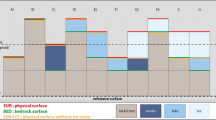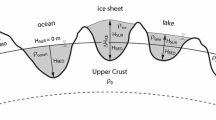Abstract
Topographic and isostatic mass anomalies affect the external gravity field of the Earth. Therefore, these effects also exist in the gravity gradients observed, e.g., by the satellite gravity gradiometry mission GOCE (Gravity and Steady-State Ocean Circulation Experiment). The downward continuation of the gravitational signals is rather difficult because of the high-frequency behaviour of the combined topographic and isostatic effects. Thus, it is preferable to smooth the gravity field by some topographic-isostatic reduction. In this paper the focus is on the modelling of masses in the space domain, which can be subdivided into different mass elements and evaluated with analytical, semi-analytical and numerical methods. Five alternative mass elements are reviewed and discussed: the tesseroid, the point mass, the prism, the mass layer and the mass line. The formulae for the potential, the attraction components and the Marussi tensor of second-order potential derivatives are provided. The formulae for different mass elements and computation methods are checked by assuming a synthetic topography of constant height over a spherical cap and the position of the computation point on the polar axis. For this special situation an exact analytical solution for the tesseroid exists and a comparison between the analytical solution of a spherical cap and the modelling of different mass elements is possible. A comparison of the computation times shows that modelling by tesseroids with different methods produces the most accurate results in an acceptable computation time. As a numerical example, the Marussi tensor of the topographic effect is computed globally using tesseroids calculated by Gauss–Legendre cubature (3D) on the basis of a digital height model. The order of magnitude in the radial-radial component is about ± 8 E.U.
Similar content being viewed by others
References
Anderson EG (1976) The effect of topography on solutions of Stokes’ problem. Rep Unisurv S-14, School of Surveying, University of New South Wales, Kensington
Ardalan AA, Safari A (2004) Ellipsoidal terrain correction based on multi-cylindrical equal-area map projection of the reference ellipsoid. J Geod 78(1–2):114–123. doi:10.1007/s00190-004-0381-6
Blakely RJ (1995). Potential theory in gravity and magnetic applications. Cambridge University Press, New York, 441
Bouman J and Koop R (2003). Geodetic methods for calibration of GRACE and GOCE. Space Sci Rev 108: 293–303
Bronstein IN (1997). Taschenbuch der Mathematik. Verlag Harri Deutsch, Frankfurt am Main
Burden RL and Faires JD (1993). Numerical analysis, Fifth edn. PWS Publishing Company, Boston
Denker H (2006). Das Europäische Schwere- und Geoidprojekt (EGGP) der Internationalen Assoziation für Geodäsie. Z.f. Verm.wesen 131: 335–344
Engeln-Müllges G and Reutter F (1987). Numerische Mathematik für Ingenieure.. BI Wissenschaftsverlag, Zürich
Faires D and Burden R (2003). Numerical methods. Third edn. Thomson Brooks/Cole, Pacific Grove
Forsberg R (1984) A study of terrain reductions , density anomalies and geophysical inversion methods in gravity field modelling. Rep 355, Department of Geodetic Science, The Ohio State University, Columbus
Forsberg R and Tscherning CC (1997). Topographic effects in gravity modelling for BVP. In: Sansò, F and Rummel, R (eds) Geodetic boundary value problems in view of the one centimetre geoid. Lecture notes in earth sciences, vol. 65, pp 241–272. Springer, Berlin
Grüninger W (1990) Zur topographisch-isostatischen Reduktion der Schwere. PhD thesis, Universität Karlsruhe
Heck B (2003) On Helmert’s methods of condensation. J Geod 77(3–4): 155–170. doi:10.1007/s00190-003-0318-5
Heck B and Wild F (2005). Topographic reductions in satellite gravity gradiometry based on a generalized condensation model. In: Sansò, F (eds) A window on the future of geodesy., pp 294–299. Springer, Berlin
Heck B, Seitz K (2007) A comparison of the tesseroid, prism and point-mass approaches for mass reductions in gravity field modelling. J Geod 81(2):121–136. doi:10.1007/s00190-006-0094-0
Janák J, Mikula K, Šprlák M (2007) Downward continuation of satellite gradiometric data. Proc. of the third international GOCE user workshop, ESA-ESRIN, Frascati, Italy, 6–8 November 2006 (ESA SP-627, January 2007), CD-Rom
Klees R (1992) Lösung des fixen geodätischen Randwertproblems mit Hilfe der Randelementmethode. Reihe C, Heft Nr. 382, Deutsche Geodätische Kommission, München
Koop R, Visser P, Tscherning C (2001) Aspects of GOCE calibration. International GOCE user workshop, vol. WPP-1888, pp 51–56
Kuhn M (2000). Geoidbestimmung unter Verwendung verschiedener Dichtehypothesen. Reihe C, Heft Nr. 520. Deutsche Geodätische Kommission, München
Kühtreiber N, Kraiger G, Meurers B (1989) Pilotstudien für eine Bouguer-Karte von Österreich. In: Lichtenegger H, Steinhauser P, Sünkel H (eds) Tagungsbericht über das 5. internationale Alpengravimetrie-Kolloquium. Österreichische Beiträge zu Meteorologie und Geophysik, Heft 2, S. 51–71, Wien
Mader K (1951) Das Newtonsche Raumpotential prismatischer Körper und seine Ableitungen bis zur dritten Ordnung. Österreichische Zeitschrift für Vermessungswesen Sonderheft 11, Österreichischer Verein für Vermessungswesen
Makhloof A, Ilk KH (2005) Far-zone topography effects on gravity and geoid heights according to Helmert’s methods of condensation and based on Airy-Heiskanen model. Proc. third Minia int. conf. for advanced trends in engineering
MAPLE (2003) Maplesoft, Version 9.03. Source http://www.maplesoft.com/
Martinec Z (1998). Boundary-value problems for gravimetric determination of a precise geoid. Lecture notes in earth sciences 73. Springer, Berlin
Nagy D (1966). The gravitational attraction of a right rectangular prism. Geophysics 31(2): 362–371
Nagy D, Papp G, Benedek J (2000) The gravitational potential and its derivatives for the prism. J Geod 74(7–8):552–560. doi:10.1007/s001900000116
Nagy D, Papp G, Benedek J (2002) Corrections to “The gravitational potential and its derivatives for the prism”. J Geod 76(8):475 doi:10.1007/s00190-002-0264-7
Novák P (2000) Evaluation of gravity data for the Stokes-Helmert solution of the geodetic boundary value problem. PhD Dissertation, Technical report of the Department of Geodesy and Geomatics Engineering, 207, University of New Brunswick, Fredericton
Novák P, Vanićek P, Martinec Z, Véronneau M (2001) Effects of the spherical terrain on gravity and the geoid. J Geod 75:691–706. doi:10.1007/s00190-005-0435-4
Novák P, Grafarend EW (2005) Ellipsoidal representation of the topographical potential and its vertical gradient. J Geod 78(11–12):691–706. doi:10.1007/s00190-005-0435-4
Schwarz HR (1993). Numerische Mathematik. Teubner Verlag, Stuttgart
Stroud AH (1974). Numerical quadrature and solution of ordinary differential equations. Springer, Berlin
Tscherning CC (1976). Computation of the second-order derivatives of the normal potential based on the representation by a Legendre series.. manuscripta geodaetica 1(1): 71–92
Tsoulis D (1999) Analytical and numerical methods in gravity field modelling of ideal and real masses. Reihe C, Heft Nr 510, Deutsche Geodätische Kommission, München
Vanićek P, Novák P, Martinec Z (2001) Geoid, topography, and the Bouguer plate or shell. J Geod 75(4):210–215. doi:10.1007/s001900100165
Vanićek P, Tenzer R, Sjoberg LE, Martinec Z and Featherstone WE (2004). New views of the spherical Bouguer gravity anomaly. Geophys J Int 159(2): 460–472
Wild F, Heck B (2004) Effects of topographic and isostatic masses in satellite gravity gradiometry. Proc. second international GOCE user workshop GOCE, The Geoid and Oceanography, ESA-ESRIN, (ESA SP – 569, June 2004), CD-ROM
Wild F and Heck B (2005). A comparison of different isostatic models applied to satellite gravity gradiometry. In: Jekeli, C, Bastos, L and Fernandes, J (eds) Gravity, geoid and space missions, pp 230–235. Springer, Berlin
Wild-Pfeiffer F, Heck B (2006) Topographic and isostatic reductions for use in satellite gravity gradiometry. VI Hotine-Marussi symposium of theoretical and computational geodesy: challenge and role of modern geodesy, Wuhan, May 29 – June 2, 2006, in press
Wild-Pfeiffer F (2007) Auswirkungen topographisch-isostatischer Effekte auf die Satellitengradiometrie. Reihe C, Heft Nr 604, Deutsche Geodätische Kommission, München
Author information
Authors and Affiliations
Corresponding author
Electronic Supplementary Material
Below is the Electronic Supplementary Material.
Rights and permissions
About this article
Cite this article
Wild-Pfeiffer, F. A comparison of different mass elements for use in gravity gradiometry. J Geod 82, 637–653 (2008). https://doi.org/10.1007/s00190-008-0219-8
Received:
Accepted:
Published:
Issue Date:
DOI: https://doi.org/10.1007/s00190-008-0219-8




